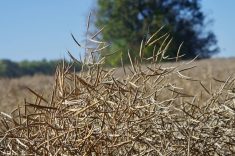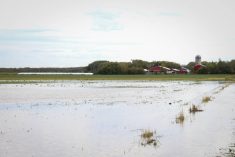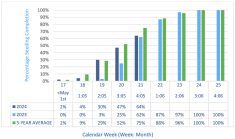Southwest Region
Above 0C and sunny weather prevailed much of last week following the snow, with rain showers near Killarney and Mountainside. Some +10C daytime temperatures occurred, but overnight freezing slowed snowmelt in southern and eastern districts. Pockets around Hamiota, Miniota, Russell and west of Virden did not get as much snow compared to other areas, allowing producers to get some crop into harvested. Harvest progressed last week only in these areas. Some producers have tried modifying harvest equipment; but many were unable to cover large acres since soil moisture levels are still too high to drive. Some producers have started fall fertilization and other field tillage operations.
Read Also

June brings drought relief to western Prairies
Farmers on the Canadian Prairies saw more rain in June than they did earlier in the 2025 growing season
Overall, harvest is 65 per cent done. Over the past week, producers have been working on canola and completion remains near 60 per cent. Moisture levels are high and producers are drying most of the crop coming off this week. Some sprouting has been reported.
Spring wheat is 85 per cent harvested in the region. Some fields remain unharvested in northern parts of the region. Most remaining cereal crops are feed quality due to sprouting and mildew; producers are leaving them to harvest canola and soybeans.
Soybean harvest is about 20 to 25 per cent harvested, and the majority has been harvested wet, around 17 to 20 per cent moisture content. Yields are reported to be in the 30 to 40 bu/ac range.
There was some flax harvested last week, since farmers are trying to get at crops that are standing well, given the situation faced. Overall 20 to 25 per cent flax crop is harvested. Yields reported so far are in the 25 to 30 bu/ac range.
Corn is drying down. About 35 to 40 per cent corn silage has been made. Cattle are on fall grazing pastures and harvested fields. Some producers have started to feed. Rain and snow has helped improve grazing and filling dugouts. Concerns about corn silage exist, as many acres remain out due to the wet conditions. Standing corn is starting to dry down and in some cases breakdown from strong winds.
Northwest Region
Due to the previous heavy snowfall near Dauphin, Ste. Rose, and surrounding areas, harvest operations have seen limited progress. Some harvest operations were able to resume in Swan River and Roblin and as normal in The Pas, due to limited precipitation.
Red spring wheat harvest is estimated at approximately 95 per cent complete in all parts of the region. Canola harvest is 85 per cent complete at Roblin, 95 per cent at The Pas and Swan River and remains at 85 per cent in Dauphin. Canola yields range from 50 to 70 bu/ac. Soybeans that have been recently harvested have been challenged with high moisture. Yields ranged from 25 to 35 bu/ac in Swan River; 33 to 41 bu/ac in Roblin. Soybean harvest at Roblin is mostly complete; 90 per cent at Swan River; 65 per cent in Ste. Rose area; Dauphin remains 75 per cent complete. Flax harvest is done in Swan River with 50 per cent remaining standing in Roblin. Harvest of grain corn has started in the Ste. Rose area.
The first snowstorm of the season wreaked havoc on most of the area between the Riding and Duck Mountains particularly in the Dauphin, Ethelbert, Rorketon and Westlake areas once again. Significant power line damage was incurred in the Westlake area in particular. Any remaining annual crops including a significant amount of standing corn for silage were covered in heavy wet snow and severely damaged. Fields are saturated and additional moisture will make harvest even more difficult or may not happen at all. Much of the snow remained in the Parkland area for a week after the storm. Many corn silage fields are outside of normally fenced areas, and outside of the availability of water, potential consequences might be a higher than normal cattle cull rate due to feed shortage. Producers will be feeding a month longer this year than in 2018 as almost all cattle are now being fed. Water supply now looks sufficient. Silaging efforts will be ongoing as the weather conditions allow. In the Swan River area, silaging is almost 75 per cent complete.
Central Region
The week started with the region covered with snow. As a result, as much as 50 to 65 cm of snow had accumulated in fields. Many areas affected by power outages affected the ability to run aeration fans for stored grain, have progressively recovered. Daytime temperatures were above 0C and snow gradually melted causing spring-like runoff conditions where ditches, creeks and rivers temporarily swelled to capacity. Snow is nearly gone in the Red River Valley but remains in parts of fields and ditches west of the escarpment. Precipitation was minimal this week ranging from 0 to 5 mm.
Harvest stalled until the weekend when conditions allowed for corn, sunflower and potato harvest to resume. Soils are saturated with water making harvest operations difficult to preventing return to fields. Growers are hoping to return to harvesting operations this upcoming week, where field conditions allow.
Overall harvest is estimated at nearly 90 per cent complete with mostly soybeans, field beans and corn remaining in the region and some canola west of the escarpment. Standing corn, soybean and sunflower have tolerated heavy snow reasonably well.
Most tillage and fertilizing operations are delayed due to wet field conditions and incomplete harvest. Winter cereals are at the 2 to 3 leaf stage and uniform with the abundant moisture.
Corn harvest resumed on the weekend in the Red River Valley with about 15 per cent done in the Altona area. No yield report at this time but grain moisture content in the 28 to 32 per cent range. Silage corn harvest progressed where field access was possible.
No soybean fields harvested this week. Soybean harvest varies from 10 per cent done west of the escarpment to 25 per cent in the Altona area and as much as 60 per cent complete in the Carman area. Sunflower harvest progressed some but remains difficult with machinery causing ruts in the fields. Harvest of sunflower is 10 to 15 per cent done in the Altona area.
No field beans harvested last week. Seed quality suffered greatly from the recent poor weather. Seed grade is being assessed with the crop standing to determine if worth harvesting. Harvest progress for this crop remains at 40 to 50 per cent.
Canola harvest is around 95 per cent done in the region. Swathed canola fields have been pushed deeper into the stubble from the snow, and suffer from sprouting damage and are slow to dry. Harvest of many of those remaining fields is questionable. Flax harvest progress remains at 60 per cent west of the escarpment to 100 per cent below the escarpment.
Commercial potato harvest progressed but slowed with the wet conditions. Reports of 70 per cent harvest complete.
The snow has mostly disappeared allowing grazing to resume on pasture and on second and third cut hay fields. Cattle are being rounded up from pasture and brought home. Calves are being weaned and marketed. Calves still on pasture are being creep fed grain.
Corn silage harvest has begun again on the sandier soils where equipment can travel. There is concern that producers will not be able to chop on a timely basis before the corn dries down to much. Hay and cattle yards are very wet making them difficult to work in to move feed, cattle or manure. There are reports of cattle losses because of the storm and muddy, wet conditions.
Livestock producers in need of feed and wanting to harvest additional hay and greenfeed are having difficulty with the wet weather. Early tests of greenfeed are showing signs of nitrates because of either dry growing conditions or frost stress. Some dugouts that were dry have recharged with rain and runoff.
Eastern Region
Over the last week, precipitation accumulation in the region ranged from a 1 to 10 mm occurring as intermittent rain or drizzle with occasional light wet snow. Daytime temperatures did not rise to double digits until the weekend and skies were most often overcast, leading to poor soil drying conditions. There was very limited harvest progress with producers moving from field to field, attempting to find dry spots. Most of the crop harvested was very tough with grain dryers and aeration systems being used. Significant field rutting occurred wherever producers tried to make progress. Some producers decided to stay out of fields to avoid rutting and/or the high costs of drying. Soils are saturated with standing water apparent. Mould continued to be observed in corn crops as well as significant levels of head rot in sunflowers. Sunflower stems in some fields were breaking down and snapping under the weight of heads. Some local rivers and streams continued to overflow their banks and flood fields and pastures. Grain producers have been marketing grain and moving grain around their farms to make room in aeration bins for future harvesting. Many feel the chances of significant soil drying are slim given the time of year. Harvesting on frozen ground once it gets consistently cold enough is viewed as a possible opportunity if such weather does not include snowfall.
Only limited harvest progress occurred for wheat, oats, and canola in northern districts. Soybean harvest was about 20 per cent complete. Yield reports ranged from 30 to 40 bu/acre with mostly good quality. Sunflower harvest remained at 10 per cent complete with no notable harvest progress made. Corn silage harvest was approximately 50 per cent complete with yields of 15 to 20 tons/acre and the weather continuing to delay progress. About 10 per cent of grain corn acres were harvested but grain moistures ranged from 34 to 38 per cent with grain dryers being used to bring the grain down to safe storage moistures. Grain dryer and steeping bin capacities were limiting corn harvest progress. Overall harvest progress for the region was about 70 per cent complete.
Reduced silage acreage harvested and no third hay cut continue to exacerbate feed shortage problems. Some secondary roads continue to be impassable making the movement of feed and cattle difficult. Feeding areas continued to be saturated and muddy making feeding operations difficult. Supplemental feeding on pastures continued.
Interlake Region
Harvest is at a near standstill. Minimal additional rain since the storms of Thanksgiving weekend, but cloudy conditions and misty rains have allowed for little drying. Almost all snow has now melted, although some remains in unharvested crop and north facing areas. Snowfall amounts generally declined from west to east; higher amounts were also seen in some areas in the north. The storms caused power outages affecting farm operations including aeration and drying. The west side of the region was hardest hit. 50 per cent of RM of Grahamdale now has power, with 90 per cent power in the remaining hard hit municipalities.
Wet snow has caused crop lodging in some fields, which continues to delay harvest; it will be difficult for those areas to dry. Fields are rutted up, and more reports of combines getting stuck. Ruts were a problem in areas of heavy rain even before the storms. Based on experience in previous years, some chose to wait, due to the extensive damage that can affect crops for several years following.
Declining quality will be an issue in unharvested crop.
Even with the snow, many soybean and cornfields are still standing well; some growers were able to harvest on the weekend where the ground had firmed up, and in drier areas and lighter soils. The wettest fields will not be touched until hard frosts or frozen ground allow machinery back on.
Harvest progress is estimated as 75 to 80 per cent complete for the region, with some areas higher. Yields are highly variable, but much has come in at average to slightly below average.
All but the last few cereal fields have been harvested; lodging, sprouting and green growth are issues in remaining crop, and quality continues to decline.
Canola harvest is estimated at 85 per cent complete. Much of the standing canola has been flattened by heavy wet snow.
Producers able to harvest worked on soybeans; if that was not possible, some tried out corn. Soybeans with branches saw more damage from the snow, compared to those with single stalks. Some report as much as 50 to 65 per cent harvested, and a few have finished up. Many have not started due to poor field conditions and some longer season varieties. T otal acres complete for the region fall in the 35 per cent range.
Some sunflowers were harvested on the weekend, no yield reports to date. Of the remaining fields some are standing well, some have been hurt by the heavy wet snow.
Most seed alfalfa harvest is complete. Acres remaining have been flattened by snow. Some acres have been written off; others are seeing very good yields.
Average yield at this point expected to be in the 300 to 500 lb/ac range.
Silage corn harvest is at a standstill. Some grain corn has been harvested, but much of the crop is still at high moisture levels. Some lodging evident, but not as much as expected.
Tillage operations continue where possible, and some areas are working well. Producers are picking and choosing fields, with some fields only partly done due to the wet conditions.


















